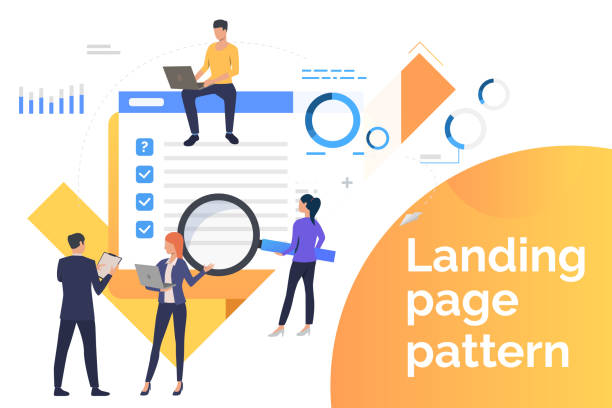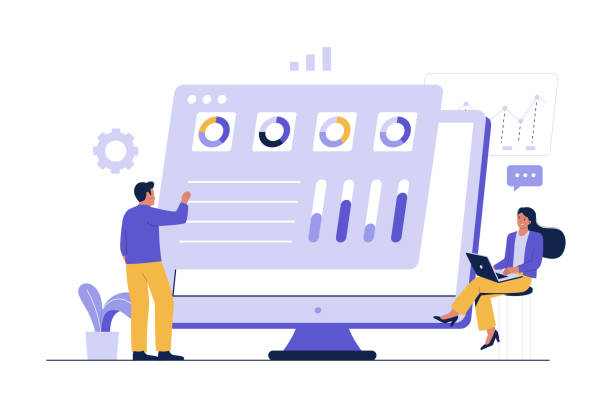Introduction to Responsive Website Design and its Importance

In today’s digital world, website design is no longer limited to displaying content on a desktop screen.
Users access the internet from various devices such as smartphones, tablets, laptops, and even smart TVs.
This is where the concept of #Responsive_Web_Design becomes vital.
This approach ensures that your website is displayed in the best possible way, regardless of the screen size or the user’s device, providing a seamless user experience.
This is a paradigm shift in web design that can no longer be ignored.
The main goal of this advanced technique is to create flexibility in layout, images, and content so that they automatically adapt to screen dimensions.
This is an educational and crucial topic for every modern web developer.
Are you losing potential customers due to an unprofessional website? RasaWeb is your answer! With our specialized corporate website design services:
✅ Enhance your business’s credibility and standing
✅ Experience attracting more targeted customers
⚡ Act now to receive a free consultation!
Why is Responsive Design Essential for Modern Websites?

Why should we prioritize responsive website design? This is a question many businesses and developers ask themselves.
The answer is simple: User Experience (UX) and Search Engine Optimization (SEO).
Google has explicitly stated that it prefers responsive websites in its search results, especially for mobile searches.
This means that if your site is not responsive, you might rank lower in competition with responsive websites.
Furthermore, users expect to be able to easily use your website on any device; if you don’t provide this, they will quickly leave your site and go to your competitors.
This is an important analysis of today’s market needs and is considered an essential guide for anyone who wants a successful online presence.
In fact, neglecting this aspect can lead to loss of customers and reduced traffic.
Technical Principles of Responsive Website Design: Fluid Grids and Flexible Media

At the heart of responsive website design are two key concepts: Fluid Grids and Flexible Media.
Fluid grids use relative units like percentages for element widths instead of fixed pixels.
This approach allows elements to adjust their size with changes in screen dimensions.
Flexible media includes images and videos that are adjusted using CSS so they never overflow their container width and display well at any size.
This specialized aspect of website design requires a deep understanding of CSS and HTML.
This educational section helps you understand the technical foundation of a responsive website.
Below, a comparison table between traditional and responsive design approaches is presented, highlighting the key differences.
| Feature | Fixed Design | Responsive Design |
|---|---|---|
| Element Sizing | Fixed Pixels (px) | Percentage, em, rem, vw/vh |
| Device Compatibility | Limited to specific resolutions | Compatible with any screen size |
| Maintenance | Requires separate versions for mobile and desktop | A single codebase |
| User Experience | Different experience on various devices | Unified and optimized experience |
| SEO | May have a lower ranking on mobile | Preferred by search engines |
Tools and Frameworks for Responsive Development

To effectively implement responsive website design, developers utilize various tools and frameworks.
Among the most popular is Bootstrap, which provides a collection of HTML, CSS, and JavaScript tools for developing responsive, mobile-first websites.
In addition to Bootstrap, native CSS techniques such as Flexbox and CSS Grid also play a vital role in creating flexible layouts.
Flexbox is ideal for one-dimensional layouts (row or column), and CSS Grid is ideal for two-dimensional layouts (simultaneous rows and columns).
Using these specialized tools can accelerate the development process and ensure that your design functions correctly across different devices.
This section provides practical guidance for choosing the right technologies and introduces you to the latest methods.
Does your current website convert visitors into customers or drive them away? Solve this problem forever with professional corporate website design by RasaWeb!
✅ Build powerful credibility and branding
✅ Attract target customers and increase sales
⚡ Get a free consultation now!
Performance and Speed in Responsive Websites

One of the significant challenges in responsive website design is maintaining performance and loading speed.
Responsive websites must be optimized to load quickly on various devices, especially on mobile with slower internet connections.
This includes optimizing images (using responsive images, compression, and lazy loading), reducing the size of CSS and JavaScript files, and employing caching.
Neglecting these issues can lead to a poor user experience and users abandoning the site.
This is an important analytical topic that requires careful and strategic planning in the initial stages of design and development.
Tools like Google PageSpeed Insights can help you identify performance bottlenecks and improve site speed.
Common Challenges and Issues in Responsive Website Design

Despite numerous advantages, responsive website design is not without its challenges.
One common issue is managing content for different screen sizes.
Sometimes, content designed for desktop loses its readability or appears excessively long on mobile.
Another challenge is ensuring the correct functioning of scripts and animations on various devices.
Improper planning can lead to a loss of control over the site’s layout and appearance on certain devices.
Furthermore, complexity in testing and debugging is another obstacle.
These are challenging issues that require creative and specialized approaches to solve them.
Guidance for preventing these problems includes Mobile-First Design and continuous testing.
Testing and Debugging Responsive Websites

Testing a responsive website is a crucial step to ensure its proper functioning across all devices and browsers.
Given the vast diversity of devices, one cannot expect your site to display flawlessly on all of them.
Using browser simulation tools (such as developer mode in Chrome or Firefox) can be helpful, but #actual_testing on physical devices is essential.
Platforms like BrowserStack or LambdaTest allow you to test your site on hundreds of device and browser combinations.
This educational and specialized section introduces effective tools and methods for debugging a responsive website.
| Testing Tool | Capabilities | Application |
|---|---|---|
| Chrome DevTools | Device simulation, responsive mode, dimension adjustment | Initial testing and quick debugging |
| BrowserStack / LambdaTest | Testing on real devices (cloud), various browsers | Comprehensive compatibility and performance testing |
| Responsive Design Checker | View site in default sizes | Quick layout check in standard dimensions |
| Google Mobile-Friendly Test | Check site’s mobile compatibility from Google’s perspective | Mobile SEO validation |
Impact of Responsive Website Design on Business and Marketing

Implementing a responsive website design goes beyond a technical decision; it’s a strategic investment for any business.
Responsive websites have lower Bounce Rates and higher Conversion Rates because they offer a better user experience.
This translates to increased user engagement, improved SEO, and ultimately, growth in sales and revenue.
From a marketing perspective, a responsive website allows you to target all users on any device with a single campaign, leading to savings in time and cost.
This is good news for any business that wants to remain competitive in the online space.
This is a comprehensive analysis of Return on Investment (ROI) in web design.
Did you know that a poor corporate website costs you many opportunities daily? Solve this problem forever with professional corporate website design by RasaWeb!
✅ Create a powerful and trustworthy image for your brand
✅ Attract targeted new customers and increase sales
⚡ [Get a free website design consultation]
Beyond Responsive: The Future of Web Design

While responsive website design has become an industry standard, the web world does not stand still.
New concepts such as Adaptive Design, which provides entirely different versions of a site based on the device, as well as advancements in Progressive Web Apps (PWAs), which offer a user experience close to a mobile application, are emerging.
These approaches complement responsive design and aim to provide an even more optimized and faster experience.
The future of web design is moving towards creating fully personalized and faster experiences on every platform.
This is an exciting and forward-looking aspect of web design that can broaden your perspective on future capabilities.
Conclusion: The Necessity of Responsive Website Design in Today’s Era

In conclusion, responsive website design is no longer a luxury option, but an undeniable necessity for any website that aims to succeed in today’s world.
From improving user experience and increasing search engine rankings to saving development and maintenance costs, the benefits of responsive websites are countless.
Adopting this approach means investing in the future of your online business and ensuring your site’s accessibility and efficiency for all users.
This article serves as a comprehensive guide, clarifying the importance and implementation of this technology.
By correctly implementing the principles of Responsive Design, you can ensure that your website is ready for the challenges of today’s and tomorrow’s digital world.
Frequently Asked Questions
| Question | Answer |
|---|---|
| What is Responsive Web Design? | It is an approach that ensures your website’s layout displays well on any device (such as mobile, tablet, and desktop) and adapts to the user’s screen size. |
| Why is responsive design important? | Improved user experience across various devices, increased visits and conversion rates, better search engine rankings (SEO), and reduced need for separate mobile version development. |
| How is responsive design implemented? | By using CSS media queries to apply different styles based on device characteristics (like screen width), employing fluid grids, and flexible images. |
| What are the main technologies used in responsive design? | HTML5, CSS3 (especially Media Queries), and JavaScript. |
| What are the main benefits of responsive design? | Unified user experience across different devices, easier website maintenance, better SEO (as Google prefers responsive sites), and cost and time savings compared to developing a mobile application or a separate site. |
And other services of RasaWeb Advertising Agency in the field of advertising
Smart Direct Marketing: A creative platform for improving digital branding by customizing user experience.
Smart Marketing Automation: A creative platform for improving campaign management by optimizing key pages.
Smart Conversion Rate Optimization: A dedicated service for growing campaign management based on customizing user experience.
Smart Brand Identity: Designed for businesses looking to improve SEO ranking through the use of real data.
Smart Google Ads: Designed for businesses looking to increase click-through rates by optimizing key pages.
And over a hundred other services in the field of internet advertising, advertising consultation, and organizational solutions
Internet Advertising | Advertising Strategy | Sponsored Article
Resources
What is Responsive Website Design and Why is it Important?
New Trends in Web Design and the Future of the Internet
Benefits of Using Responsive Design in SEO and User Experience
Optimizing the Performance of Responsive Websites for Mobile
? For the growth and prosperity of your business in the digital world, RasaWeb Afarin partners with you. With our comprehensive services, including responsive website design, professional SEO, and content marketing, we pave your path to success.
📍 Tehran, Mirdamad Street, next to Bank Markazi, Southern Kazeroon Alley, Ramin Alley, No. 6



